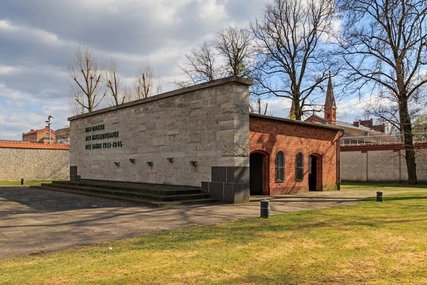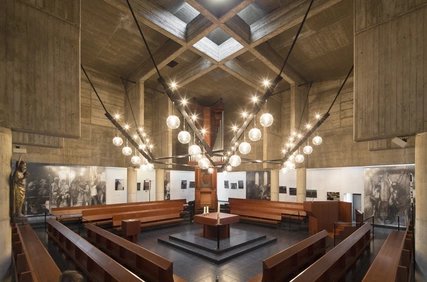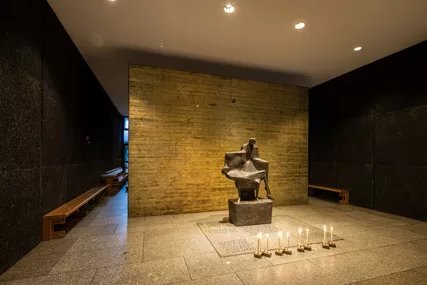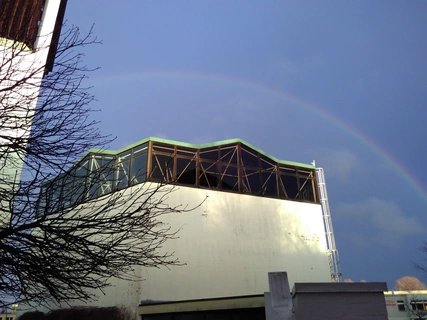
The path of remembrance
Down the trail of the victims of Nazi justice and resistance
The path of remembrance in the Berlin district of Charlottenburg connects a memorial with three memorial churches and commemorates the victims of the Nazi justice system and the resistance.
The path of remembrance is located in the northern part of Charlottenburg in Berlin. It connects the Plötzensee memorial with three nearby churches that are dedicated to the memory of the resistance against National Socialism.
Touching places of remembrance and ten steles
The path opened in 2018. Ten pillars of information on the way between the Plötzensee Memorial, the Katholische Kirche Maria Regina Martyrum, the Evangelische Sühne-Christi-Kirche and the Evangelische Gedenkkirche Plötzensee take us down the memory lane, reminding us about the victims of dictatorship.
En route this path of remembrance along Heckerdamm, you will also cross the Paul Hertz settlement, which was built in the 1960s. The special thing about this modern housing estate is that all the streets here have been named after critics of the Nazi regime. The settlement itself is named after the politician Paul Hertz, who fled Germany to Prague in April 1933 and immigrated to the USA in 1939. He was involved in the reconstruction of Berlin from 1949 onwards.
Plötzensee Memorial

The Plötzensee Memorial is one of the oldest memorial sites in Berlin. Soon after the end of the Second World War, the men and women killed here were commemorated at this execution site. The executions took place in a shed, a part of which is preserved even today. More than 2800 death sentences were carried out in this “execution shed” between 1933 and 1945, often on people who were resisting the Nazi regime.
The shed is dark inside. The arched windows provide very little light. A steel beam with hooks is attached across the room. Until 1945, there was also a guillotine here that was used to carry out beheadings. Later, the wide steel beam with iron hooks was added so that convicts could also be hanged.
The room where the executions took place is now a memorial room. Right next door, a permanent exhibition provides information about the National Socialist injustice. The many individual fates of people who were killed in the Plötzensee prison between 1933 and 1945 are especially impactful. These people belonged to 20 different nations. The Plötzensee Memorial is also a European place of remembrance for all victims of National Socialism from Germany and abroad.
Evangelische Gedenkkirche Plötzensee

If you follow the path of remembrance to the Paul Hertz settlement, you will see a simple concrete building on Heckerdamm: This is the Plötzensee Evangelical Community Centre, inaugurated in 1970, along with its memorial church. From the outside, this does not look like a church at all. The aim here was to create a “place of social work” aligned with its immediate surroundings. There was absolutely no external “sacrality”. Only the concrete cross in the front yard indicates that this is a Christian place.
What is equally unexpected is one of the most significant works of contemporary church art in Berlin awaiting you inside. From the beginning, the church hall was intended to not only be a meeting place for the community, but also a memorial to the victims of Plötzensee. Alfred Hrdlicka was hired for the artistic design. He created the “Plötzensee Dance of Death”. The Viennese painter and sculptor has depicted the threat that power, arbitrariness and violence poses on 16 large-sized panels that are 3.50 m high and 0.99 m wide. In order to do this, he has combined biblical motifs with impressions of the former Plötzensee execution site, such as the guillotine. The room in the “execution shed”, which has been preserved to this day, with its striking arched windows and the beam with hooks, can also be found in the pictures.
The modern design of the church interior is also striking: the upper part of the room consists of a windowless cube made of raw exposed concrete. This is deliberately intended to remind one of a bunker or a cell. Following the reformist ideas from the 1960s, the altar is located at the centre of the room. The seats are arranged around the altar in a square. This makes it easier to experience the service as a community. The rooms of the Evangelische Gedenkkirche Plötzensee house the Ecumenical Memorial Centre “Christians and Resistance” since 2009.
Katholische Gedenkkirche Maria Regina Martyrum (Maria Regina Martyrum Catholic Commemorative Church)

Just a few steps away from the Protestant memorial church is the Maria Regina Martyrum Catholic memorial church for German Catholics, built between 1960 and 1963. Thanks to its firm, straight lines, this church stands out even from afar. The dark courtyard, the “celebration yard”, is once again created as a brutalist place of silence and seclusion. This is where you enter the church from when coming from Heckerdamm. The dark pavement and the black pebble walls are intended to be reminiscent of the roll call area in a former concentration camp. The church facade is covered with white marble pebble slabs. The bright building floats with the message of life above the dark zone of death.
The celebration courtyard also has the Stations of the Cross designed by Otto Herbert Hajek. In the sculptures on the courtyard wall that is almost four metre high are are stations of Jesus' path on the Stations of the Cross, which have been interwoven with the suffering of the people using several small crosses.
Also worth seeing is the gilded sculpture above the entrance to the church: the “apocalyptic woman” by Fritz Koenig shining in the sunlight, a topic from the Revelation of John.
A steep staircase leads to the upper area of the church has a large altar painting by Georg Meistermann: chaos and ruin using shapes and colours. Right at the centre is a lamb that symbolizes non-violence.
Daylight streams into the church through the ribbon windows “like an Easter promise in the face of Plötzensee” (architect Hans Skull).
The crypt has the extremely impressive Pietà by Fritz Koenig right above the graves. The inscription there reads: “To all martyrs who were denied the grave. And to all martyrs whose graves are not known.”
In 1984, the Carmel Regina Martyrum monastery was built next to the church, where sisters live, work and pray.
Evangelische Sühne-Christi-Kirche

The last stop on the path of remembrance is the Evangelische Sühne-Christi-Kirche. The hexagonal church, constructed in a modern style by Hansrudolf Plarre from 1962 to 1964, can be easily spotted even from a distance due to its unusual shape and free-standing triangular tower.
The front yard has a memorial wall that the Friedenau artist Florian Breuer built in 1964. The inscriptions “Auschwitz,” “Plötzensee,” “Hiroshima,” and “Walls” is a reminder of the atrocities that people committed against each other in the 20th century. In addition, an inscription in front of the memorial wall quotes God's words of warning to Cain from the Bible: “The voice of thy brother’s blood crieth unto me from the ground” (1 Moses 4,10). As you continue into the church, the inscription “Golgotha” commemorates the place where Jesus Christ was crucified.





